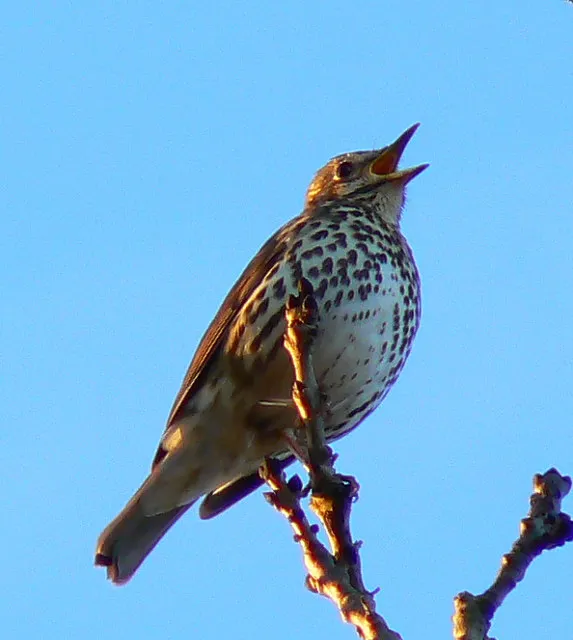
A recent article in the Washington Post, Why Birds and Their Songs are Good for our Mental Health, notes that “researchers found a significant positive association between seeing or hearing birds and improved mental well-being, even when accounting for other possible explanations such as education, occupation, or the presence of greenery and water, which have themselves been associated with positive mental health.”
Around your bird feeder, in the shrubs, or overhead in the sky you can hear birds making sounds all through the year, but during courtship and nesting in the spring oral communications between birds are much more obvious and frequent. Briefly, songs are complex sounds typically used during breeding season to attract mates and defend territories. Calls are simple sounds usually meant to convey a bit of information as to the location of a bird, to keep a flock together, to sound an alarm, etc. – like the sounds flocks of migrating geese make or the chattering around the bird feeder. Songs are only produced by birds classified as songbirds – slightly over 50% of all the birds in the world, but all of them do not produce what we would consider songs – jays and crows, for example.
It takes a bit of practice to learn to identify species by their songs or calls and it’s best to learn from someone who knows them. You can also go to ornitholo.wpenginepowered.com/songscalls.html for links to various sources of bird songs on the web. Or go to a website that provides a lot of vocalizations, like Bird-sounds.net. which has sounds of birds from the U.S. and Canada. Or for sounds from birds across the world, go to xeno-canto. One caveat; whether you try to learn songs from these sites, from tapes or cds, be aware that birds have accents, just like people. Different populations of songbirds often differ, sometimes considerably, in their songs. Song Sparrows from the east coast may sound different than those on the west. So it’s really best to learn songs in the field in your area. As I have mentioned, the Merlin app is a terrific way to identify and learn songs.
The late Luis Baptista, a fellow ornithologist and overall nice guy, worked at the Cal Academy of Sciences and studied White-crowned Sparrow songs so intensely that he could recognize individual birds by their song, like we recognize our friends’ voices.
Some philosophers and naturalists disagree, but our avian friends, unlike us, do not sing for enjoyment. Singing functions in courtship, nesting, and raising young, all necessary for survival of the species – passing genes to the next generation. But it is also dangerous – singing attracts attention and competitors and predators as well. Only males typically sing and usually males are attractively colored. Females rarely sing and are usually dull colored. Singing also only occurs in the breeding season. If singing were actually an expression of joy, both males and females would do it all year around. It may be a nice thought that the robin warbling his melodious song is expressing his happiness, but it just isn’t true.
Bird song is partly genetic and partly learned. Experiments have shown that young birds, isolated from their parents, sing a song, but it’s only partly accurate. Young birds have to learn the full song by listening to their parents the spring following the year they were hatched.